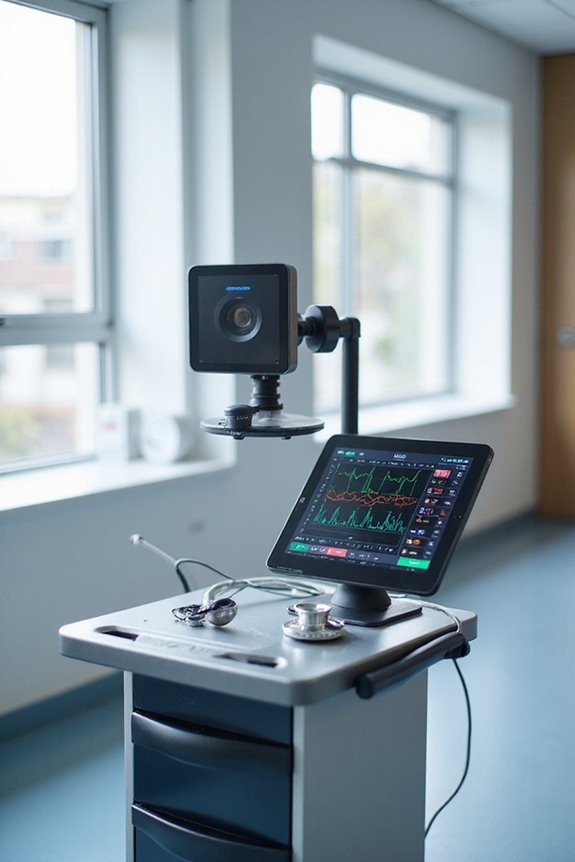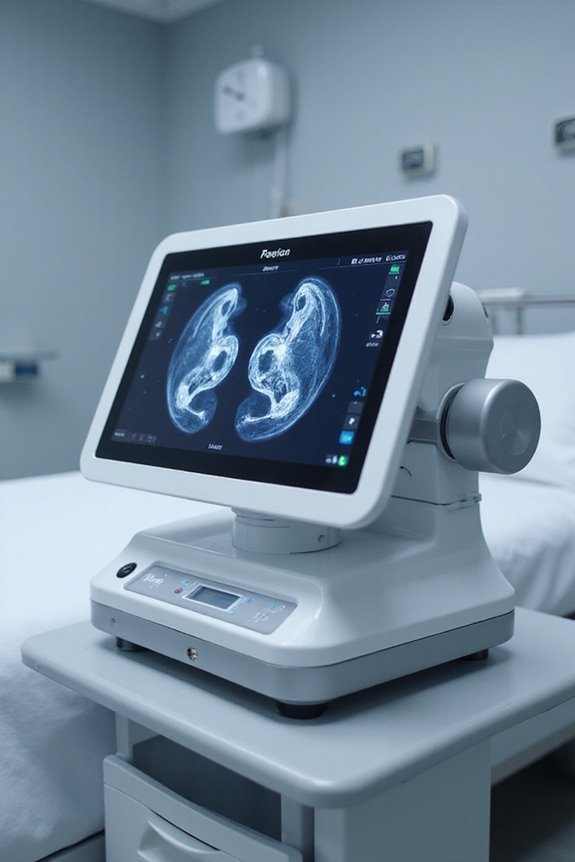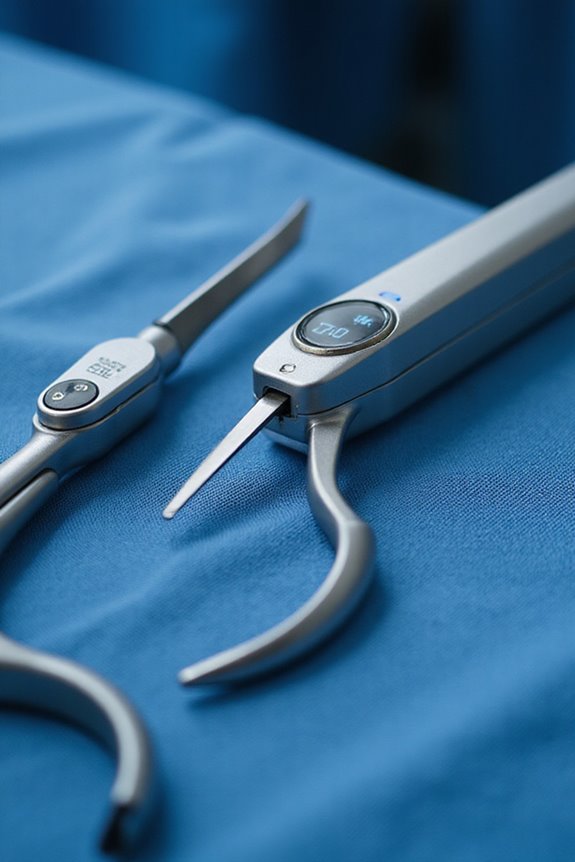Recent trends in medical safety technology include notable advancements across various sectors:
- Virtual and Augmented Reality: Enhances training, improving learning outcomes by 76%, with surgeons making 40% fewer mistakes.
- Telemedicine and Remote Patient Monitoring: Set to expand by 128% by 2027, improving chronic condition management.
- AI in Diagnostics: Over 90% accuracy in early cancer detection.
- Smart Surgical Instruments: Offer real-time feedback, enhancing precision.
These developments continue to amplify patient safety and efficiency in healthcare settings. More insights await.
Key Takeaways
- Advancements in AI diagnostics enhance accuracy, with algorithms achieving over 90% accuracy in early cancer detection, improving patient safety outcomes.
- Wearable health monitors provide continuous tracking, enabling early detection of medical issues and timely clinical interventions to enhance patient safety.
- Smart surgical instruments offer real-time feedback and ergonomic designs, improving decision-making and reducing surgeon fatigue, ultimately enhancing surgical safety.
- The rise of telemedicine incorporates AI-powered sensors, ensuring broader access to healthcare while maintaining patient safety through remote monitoring capabilities.
- Integration of cybersecurity measures in health technology is crucial to protect sensitive patient information and ensure compliance with safety regulations.
Advancements in Virtual and Augmented Reality for Training
What advancements are transforming the landscape of medical training through Virtual and Augmented Reality (VR/AR)? The integration of VR simulations is revolutionizing educational methodologies.
- Immersive training experiences enhance interactive learning, allowing medical professionals to practice complex procedures in a risk-free environment.
- Utilizing realistic 3D anatomy models fosters a deeper understanding of the human body.
- AI integration facilitates patient interaction training, essential for developing communication skills.
- Studies indicate that VR training improves learning outcomes by 76%, with surgeons trained in VR making 40% fewer mistakes than their conventionally trained counterparts.
- The projected growth of the VR medical education market, from $13.44 billion in 2022 to $123.87 billion by 2030, underscores its increasing significance in skill enhancement and professional preparation.
The Rise of Telemedicine and Remote Patient Monitoring

The rapid advancements in medical training through Virtual and Augmented Reality (VR/AR) set the stage for further innovations in healthcare delivery, particularly in telemedicine and remote patient monitoring (RPM).
- Increased Adoption: Telemedicine has evolved, integrating AI-powered sensors and real-time data collection.
- Telehealth Accessibility: Enhanced technology guarantees broader global access to healthcare services.
- Market Growth: RPM is projected to expand by 128% by 2027, with over 71 million Americans utilizing it by 2025.
- Remote Monitoring Benefits: This technology improves management of chronic conditions, enhances patient engagement, and reduces hospitalizations.
Estimates suggest that 80-90% of outpatient visits may become virtualized, reflecting a significant shift towards digital healthcare solutions. Continuous monitoring and early interventions promise better health outcomes for patients.
Artificial Intelligence Enhancements in Diagnostics

Artificial Intelligence (AI) is greatly transforming diagnostics within the healthcare sector, enhancing both efficiency and accuracy.
- AI Diagnostics: AI tools improve workflow by processing extensive medical data, streamlining laboratory tasks, and enabling real-time tracking. They are utilized in over 70% of large hospital systems globally.
- Diagnostic Accuracy: Advanced algorithms demonstrate over 90% accuracy in early-stage cancer detection, markedly improving patient outcomes. For instance, AI-assisted mammography detects 29% more breast cancers.
- Predictive Modeling: AI aids in predicting chronic disease risks and supports population health management.
The integration of AI into clinical decision-making processes empowers healthcare professionals, allowing them to focus on patient care rather than administrative burdens. This shift is crucial for future advancements in diagnostics.
Innovations in Smart Surgical Instruments

Innovations in smart surgical instruments are reshaping the landscape of surgical procedures, enhancing both efficiency and safety. These advanced tools incorporate smart instrument design, integrating computing power, sensors, and cameras to optimize surgical techniques.
Key features include:
- Real-Time Feedback: Instruments provide immediate data to surgeons, improving decision-making and patient outcomes.
- Ergonomic Design: Designed for comfort, these instruments reduce fatigue, allowing for extended use.
- High-Speed Oscillation: Surgical saws now feature advanced oscillation technology for cleaner cuts and decreased tissue trauma.
- AI-Powered Analysis: Systems analyze numerous procedures to refine techniques and enhance training.
These innovations collectively advance surgical precision, promote safety, and enhance the overall surgeon experience, fostering a more collaborative surgical environment.
The Future of Remote Robotic Surgery

As remote robotic surgery gains traction, it promises to revolutionize surgical practices by enhancing accessibility and precision in care delivery. This innovative approach addresses considerable gaps in patient access, particularly in underserved regions.
Key components include:
- Remote Control Systems: Allow surgeons to operate from vast distances.
- High-Speed Data Transmission: Guarantees real-time communication between the surgeon’s console and robotic arms.
- Advanced Visualization: Provides high-definition video feeds for enhanced surgical precision.
Emerging technologies, such as AI and machine learning, further refine the effectiveness of these systems. With reduced travel burdens and economic benefits, remote robotic surgery stands to improve patient outcomes markedly. As industry collaborations advance regulatory frameworks, the future of surgical care appears increasingly connected and accessible.
Impact of Wearable Health Monitors on Patient Safety
Wearable health monitors greatly influence patient safety by enabling continuous health tracking and early detection of medical conditions. These devices facilitate real-time monitoring of essential signs, which can identify issues like arrhythmias or diabetes complications before symptoms arise.
- Improved wearable compliance through accurate data collection supports timely clinical interventions, reducing hospital admissions.
- Integration with patient safety software enhances documentation and compliance tracking, fostering accountability within healthcare settings.
However, data security remains a significant concern, as vulnerabilities in wearable devices can lead to manipulation and dangerous treatment errors. Stronger cybersecurity measures are crucial to protect patient information and maintain the integrity of health data. Overall, the impact of wearables on patient safety is profound, with ongoing advancements shaping future healthcare practices. Furthermore, the use of continuous glucose sensors provides real-time insights that can significantly enhance patient management and safety outcomes.
Frequently Asked Questions
How Does Medical Safety Technology Reduce Human Error in Healthcare?
Medical safety technology greatly enhances error reduction through effective technology integration. By standardizing workflows and automating routine tasks, it minimizes human error, allowing healthcare professionals to concentrate on complex decisions while improving overall patient safety and care quality.
What Are the Regulatory Challenges for New Medical Safety Technologies?
In 2023, 70% of medical device companies reported facing significant regulatory hurdles. Compliance standards, particularly around cybersecurity and AI, complicate the development of new safety technologies, emphasizing the need for streamlined regulations to foster innovation and guarantee patient safety.
How Can Patients Benefit From Medical Safety Technologies?
Patients benefit from medical safety technologies through enhanced empowerment and improved technology accessibility. These advancements foster informed decision-making, strengthen communication with healthcare teams, and promote proactive health management, ultimately leading to better health outcomes and increased autonomy.
What Role Do Healthcare Professionals Play in Implementing Safety Technologies?
Healthcare professionals play a pivotal role in implementing safety technologies by coordinating training programs and facilitating technology adoption. Their expertise guarantees that staff are well-prepared and engaged, fostering a culture of safety and collaboration within healthcare environments.
How Is Patient Data Privacy Maintained in Medical Safety Technologies?
Patient data privacy in medical safety technologies is upheld through robust data encryption and strict access controls. These measures create a secure environment, fostering trust among patients and ensuring their sensitive information remains protected from unauthorized access.




